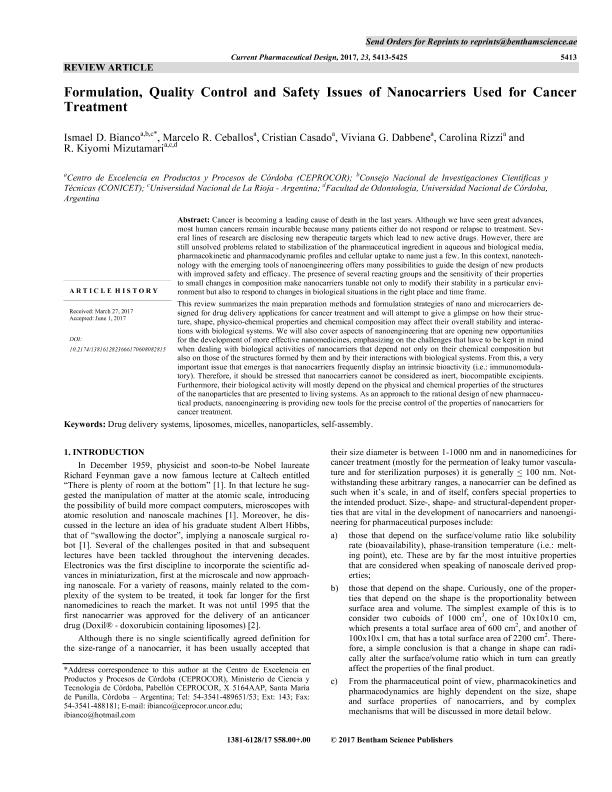Artículo
Formulation, quality control and safety issues of nanocarriers used for cancer treatment
Bianco, Ismael Dario ; Ceballos, Marcelo Ramon; Casado, Cristian; Dabbene, Viviana G.; Rizzi, Carolina; Mizutamari, Roxana Kiyomi
; Ceballos, Marcelo Ramon; Casado, Cristian; Dabbene, Viviana G.; Rizzi, Carolina; Mizutamari, Roxana Kiyomi
 ; Ceballos, Marcelo Ramon; Casado, Cristian; Dabbene, Viviana G.; Rizzi, Carolina; Mizutamari, Roxana Kiyomi
; Ceballos, Marcelo Ramon; Casado, Cristian; Dabbene, Viviana G.; Rizzi, Carolina; Mizutamari, Roxana Kiyomi
Fecha de publicación:
10/2017
Editorial:
Bentham Science Publishers
Revista:
Current Pharmaceutical Design
ISSN:
1381-6128
e-ISSN:
1873-4286
Idioma:
Inglés
Tipo de recurso:
Artículo publicado
Clasificación temática:
Resumen
Cancer is becoming a leading cause of death in the last years. Although we have seen great advances, most human cancers remain incurable because many patients either do not respond or relapse to treatment. Several lines of research are disclosing new therapeutic targets which lead to new active drugs. However, there are still unsolved problems related to stabilization of the pharmaceutical ingredient in aqueous and biological media, pharmacokinetic and pharmacodynamic profiles and cellular uptake to name just a few. In this context, nanotechnology with the emerging tools of nanoengineering offers many possibilities to guide the design of new products with improved safety and efficacy. The presence of several reacting groups and the sensitivity of their properties to small changes in composition make nanocarriers tunable not only to modify their stability in a particular environment but also to respond to changes in biological situations in the right place and time frame. This review summarizes the main preparation methods and formulation strategies of nano and microcarriers designed for drug delivery applications for cancer treatment and will attempt to give a glimpse on how their structure, shape, physico-chemical properties and chemical composition may affect their overall stability and interactions with biological systems. We will also cover aspects of nanoengineering that are opening new opportunities for the development of more effective nanomedicines, emphasizing on the challenges that have to be kept in mind when dealing with biological activities of nanocarriers that depend not only on their chemical composition but also on those of the structures formed by them and by their interactions with biological systems. From this, a very important issue that emerges is that nanocarriers frequently display an intrinsic bioactivity (i.e.: immunomodula-tory). Therefore, it should be stressed that nanocarriers cannot be considered as inert, biocompatible excipients. Furthermore, their biological activity will mostly depend on the physical and chemical properties of the structures of the nanoparticles that are presented to living systems. As an approach to the rational design of new pharmaceutical products, nanoengineering is providing new tools for the precise control of the properties of nanocarriers for cancer treatment.
Palabras clave:
Drug Delivery Systems
,
Liposomes
,
Micelles
,
Nanoparticles
,
Self-Assembly
Archivos asociados
Licencia
Identificadores
Colecciones
Articulos(CCT - CORDOBA)
Articulos de CTRO.CIENTIFICO TECNOL.CONICET - CORDOBA
Articulos de CTRO.CIENTIFICO TECNOL.CONICET - CORDOBA
Citación
Bianco, Ismael Dario; Ceballos, Marcelo Ramon; Casado, Cristian; Dabbene, Viviana G.; Rizzi, Carolina; et al.; Formulation, quality control and safety issues of nanocarriers used for cancer treatment; Bentham Science Publishers; Current Pharmaceutical Design; 23; 35; 10-2017; 5413-5425
Compartir
Altmétricas



